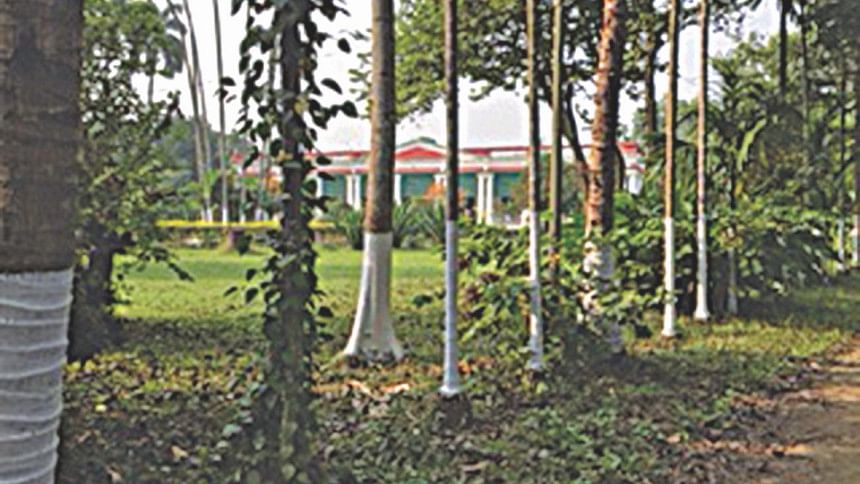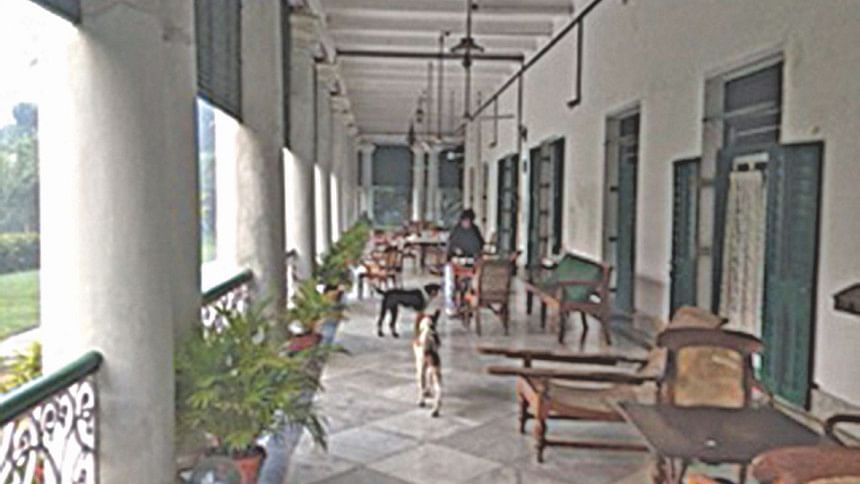THE MAN WITH THREE NATIONALITIES

"This house," said Mr Ranodhir Palchaudhuri, the owner of the colonnaded 19th century Neel Kuthi at Maheshgunj, "was built by a Frenchman, so my family was told. At some point it was bought by an Englishman named H. N. Savis, who in turn sold it to my grandfather in 1875. We don't know who the Frenchman was."
The impressive colonnaded neo-Classical mansion, once centre of a large indigo estate, stands close to the Jalangi just before it joins the Hoogly opposite Nadiya. The road to Krishnanagar runs past its front gate.
The name Savis does not sound very English and it did not take more than a flick of the Internet finger to establish (via the births, deaths and marriages columns of Calcutta registers and directories) that there were as many people called Savi in Bengal in the 19th century as there are branches of the Ficus Benghalensis.

Savis were planters of indigo in places as diverse as Malda and Kulberia, Rajmahal and Jessore. Since there was no sign of anyone called Savis, it seemed likely that H.N.'s surname of Savi had simply acquired an additionals.
Mr Palchaudhuri warned me that, in the old records, Maheshgunj had been spelt in all sorts of curious ways and so when since contemporary journals made reference to a Thomas Savi being resident at a place called Moisgunge in the middle decades of the 19thcentury, my ear perked up and the first piece of our jigsaw puzzle fell into place.
Mr Savi was having financial problems with creditors while being quarter owner of the Maheshgunj Indigo Concern in 1832-4 but was settled enough as a stalwart resident to be listed as a member of the Agricultural & Horticultural Society of India in 1842 and to be credited with providing reliable weather readings during the great cyclone of 1864.
However painstaking, probably no historian would have scoured provincial Welsh newspapers for clues to the Savi family in Bengal but an ingenious search engine did just that. In 1919 in Wales there died a man who had acquired the right to an obituary by winning a V.C. at Delhi in 1857.
The obituary records that the mother of Sir James Hill-Johnes V.C., Charlotte [Marie or Mary], was the daughter of Signor John Angelo Savi, of 1, Moisgune (the name of Maheshgunj further corrupted).
So, a generation back from its sale into Bengali hands, one part of the Maheshgunj estate (and the façade of a second house, destroyed in an earthquake, still stands), was in the possession of a Savi who was evidently Italian.
There is actually a portrait of John Angelo Savi on Flickr. His dates are given as 1765-1830 and he is said to be the son of a Florentine admiral, Antonio Savi (1720-1806) and to have married Elisabeth, daughter of the Napoleonic Marine-General André-François Corderan (1742-1816), also portrayed on Flickr.
By his marriage then, the Italian Signor Savi established a French connection and not a surprising one. Italy did not at that time exist as a nation-state and initially when the Corsican Napoleon Buonaparte, who spoke Italian before he spoke French, marched into Italy in 1796 it was at the head of a republican army of liberation.
The Net threw up a further crucial piece of information. Early in 2016, there had been a lecture on the subject of indigo planters and notably on John Angelo Savi himself by a lady who is curator of the Bath Institution in England, Madame Marie-Louise Luxemburg.
Contacted, Mme Luxemberg revealed that she was a descendant of John Angelo's daughter, Elisabeth-Theresa, who had been married out of the Maheshgunj house (to Francis William Durand, son of the Dean of Guernsey) in 1826. This, together with a date from a Calcutta journal giving the birth of a Savi boy there in August 1822, was the earliest reference we had to the family being at Maheshgunj and that a full half a century before the sale to the Palchaudhuris.
Mme Luxemburg had a comprehensive knowledge of the labyrinthine Savi family tree. John Angelo was the progenitor of them all. Born on Elba, described as Tuscan, he qualified as a physician and surgeon, served in the French navy under General de Bussy and, among other things, it is thought, acted as surgeon to Tipu Sultan when he was seeking an alliance with the French against the British.
Family legend has it that it was on a sea voyage John Angelo met and then married Elisabeth, who was possibly country-born Indian in Pondicherry, and that after their marriage they headed for Bengal to seek their fortune cultivating what came to be known as the Blue Gold.
The H.N. Savi who sold the Maheshgunj estate was Henry Nesbitt (1834-1918), one of his many grandchildren, being the son of the above-mentioned Thomas Savi (1801-1880). Henry Nesbitt had been born in the house shortly after his grandfather's death and, after selling it early on in his married life, migrated to live in Guildford in England, taking with him, it is assumed, the gold pencil-case his great-grandfather General Corderan had been given by Napoleon.
It was none of the many indigo plantations associated with the Maheshgunj Concern but the plantation John Angelo first established at Coolberia or Kulberia that points to a likely solution to the question of who the Frenchman was who built the Neel Kuthi at Maheshgunj.
We already know that John Angelo, though born Italian at a time when Italy was under foreign occupation, had married the daughter of a Frenchman. It so happens there is a book written by an Englishwoman, Mrs A. Deane, A Tour through the Upper Provinces of India, 1804-1814, in which she tells of being hospitably entertained at the Kulberia estate one Catholic Sunday.
Her host was a Frenchman, Monsieur Savi, and the only regret Mrs Deane has about a day of feasting, singing and dancing, of gaiety and (on account of so many untimely deaths) grief, in a party of 18, is that she has so little French while they are all francophones: "None of them spoke English."
While we cannot be absolutely certain of it, it seems highly likely it was John Angelo himself who, when he extended his prospering indigo interests to Maheshgunj sometime around 1820, actually built the mansion that stands there today.
"I think the Frenchman who built your house," I told Mr Palchaudhuri, "was an Italian doctor who ended up as the British-sounding Dr John Angelo Savi of Moisgunj. He was the grandfather of the Englishman who sold the house to your grandfather."
As time and tide dictated, Dr Savi had adopted three different nationalities. If his story is to have a moral, as stories did in his own times, perhaps it is that we should enjoy a national identity as something not fixed but fluid, not singular but multiple.
John Drew researched this story after staying in the house.

 For all latest news, follow The Daily Star's Google News channel.
For all latest news, follow The Daily Star's Google News channel. 



Comments